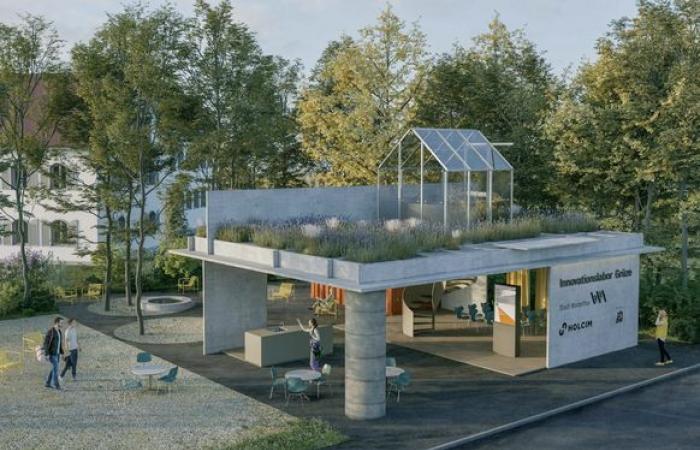These carbon-reinforced panels not only save 75% of material, but also allow for millimeter-precise construction.Image: zhaw/valentin studerus
A Swiss laboratory is proposing a new construction method that replaces steel with carbon. This innovation makes it possible to reduce the quantity of materials required by 75% compared to conventional construction techniques. A major step forward in sustainability and efficiency.
Bruno Knellwolf / ch media
Concrete is considered a real scourge for the climate. Despite some progress in recent years, the construction sector continues to consume valuable, non-renewable resources excessively. The industry is still far from reaching the goal of carbon neutrality.
In Switzerland, the construction and operation of buildings and infrastructures represent around 50% of the demand for raw materials, a third of CO emissions2 and more than 80% of the waste produced. These figures highlight the urgency of rethinking our construction practices to preserve the environment.
The production of cement, essential for the manufacture of concrete, is responsible for 8% of global CO emissions.2. Aware of this considerable environmental impact, cement plants are increasing initiatives to reduce these emissions. Among the solutions explored, “green concrete” stands out by reducing the quantity of cement used, thus offering a more ecological and promising alternative for the future of construction.
Carbon rather than steel
In Winterthur, a new building was erected in record time, revolutionizing construction with significant savings in materials and resources. The Grüze innovation laboratory was thus created without using traditional reinforced concrete. Instead, ultra-thin, reusable CPC concrete elements were used. CPC, or “Carbon Prestressed Concrete,” is characterized by carbon reinforcement rather than iron. This innovative technology marks a major advance in sustainable construction, combining performance and respect for the environment.
These carbon-reinforced panels not only save 75% of material, but also allow for millimeter-precise construction.Image:valentin studerus

Josef Kurath, the inventor of CPC concrete elements and professor at the Department of Architecture, Design and Civil Engineering at the ZHAW University of Applied Sciences in Winterthur.Image: dr
CPC plates, with a maximum thickness of eight centimeters, allow substantial savings in materials. “This technology reduces the use of materials by 75% compared to traditional concrete”explains Josef Kurath, inventor of CPC concrete elements and professor at the Department of Architecture, Design and Civil Engineering at the University of Applied Sciences (ZHAW) in Winterthur.
“In Switzerland, 2 million cubic meters of concrete are used each year for floors. If we could save 75% of material on this, it would be a huge gain”
Josef Kurath
Josef Kurath began his research more than 20 years ago. Carbon is able to withstand extremely high tensile forces, while concrete effectively resists compression. Kurath has successfully combined these two properties in “Carbon Prestressed Concrete”. Twelve years ago, he persuaded the Swiss company Silidur AG to fund his research.
After over 47,000 hours of hard work, the final product saw the light of day and maintains this innovative building in Winterthur today. This remarkable advance opens new perspectives for the future of sustainable construction.
The filigreely designed building is supported by CPC plates cut with millimeter precision from large factory-produced plates. This accuracy opens the way to a new construction method, unlike traditional concreting which does not require such precision. CPC concrete is reinforced with carbon wires every 15 millimeters, replacing steel reinforcing bars.
CPC ceilings are five times lighter than those made of conventional reinforced concrete and can be cast in plates with a thickness of four to eight centimeters. Despite this finesse, the material allows the creation of large span ceilings, thus offering architects the freedom to design spaces without intermediate supports, thus revolutionizing the possibilities of architectural design.
Assemble like a puzzle
The construction of the ceiling is based on a system of ribs, connected to a 4 centimeter thick slab, which extends over the entire width and length of the building. The plates, cut to an easily transportable size, are fitted one inside the other, and the joints are filled with mortar.

The CPC plates are assembled like a puzzle.Image: Valentin Studerus
“Like a puzzle, these plates, once assembled, form a continuous slab of unlimited dimensions”
Josef Kurath
This innovative method makes it possible to create large and uniform structures, offering unprecedented architectural flexibility.
These plates are produced in a German factory of the Swiss cement manufacturer Holcim, which has supported this project for five years. Cement plants, faced with pressure to reduce their ecological footprint, find a promising response in this innovation.
“Long considered an enemy of the climate, concrete can now be used sustainably thanks to CPC technology”
Martin Joos, municipal engineer of Winterthur
This exemplary collaboration between research and industry opens the way to more environmentally friendly construction, thus rehabilitating the image of concrete in the construction sector.
These plates have the advantage of being reusable several times. If the innovation laboratory were to be dismantled, the CPC plates could be integrated into new constructions. This technology also promotes the emergence of new business models in the construction sector. Rather than buying, it would be possible to rent the CPC plates, offering an even more sustainable and ecological solution than simply recycling materials. The reuse of resources thus opens up new perspectives for more environmentally friendly construction.
The use of carbon reinforcements as reinforcement allows an environmentally friendly approach, carbon being an organic material whose manufacture involves the extraction of carbon (C) from the air. Currently, the plates are manufactured in Germany and the company CPC AG from Kurath is still in the investment phase. The objective is to build around 300 homes per year with this technology. This would allow Holcim to build a factory in Switzerland.

The Grüze innovation laboratory in Winterthur shortly before the end of its construction.Image: Valentin Studerus
Large-scale deployment would significantly reduce the still high cost of CPC plates.
“We would then be competitive with traditional concrete. Currently our price is competitive only with wooden construction”
Josef Kurath
In partnership with Holcim, the project aims to ultimately produce an entirely Swiss product. It includes the construction of a residential building next spring, in collaboration with an architect specializing in ecological construction. This promising initiative paves the way for increased competitiveness in the construction market, while promoting the development of sustainable and environmentally friendly solutions.

What the Grüze innovation laboratory in Winterthur should look likeImage: zhaw.ch
Translated and adapted by Noëline Flippe











